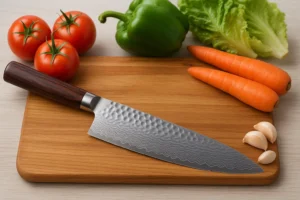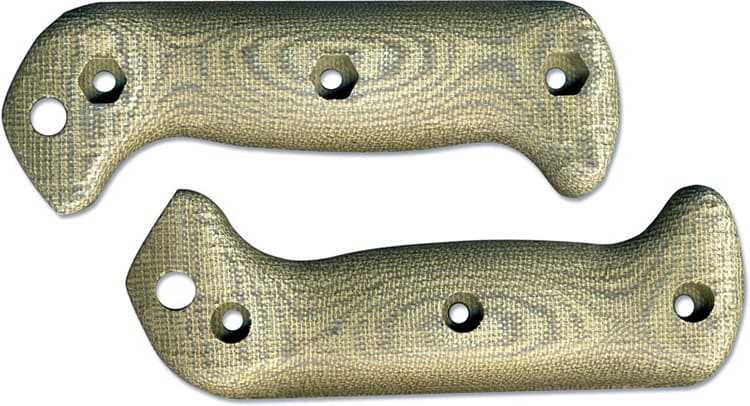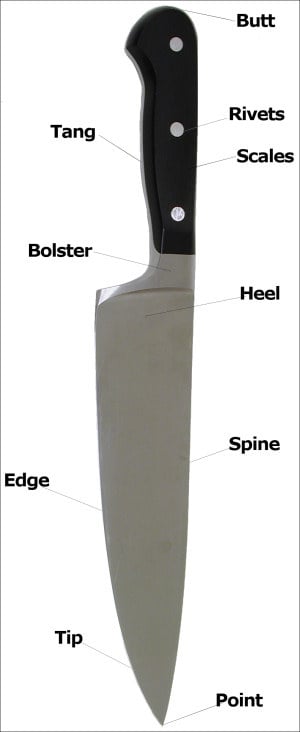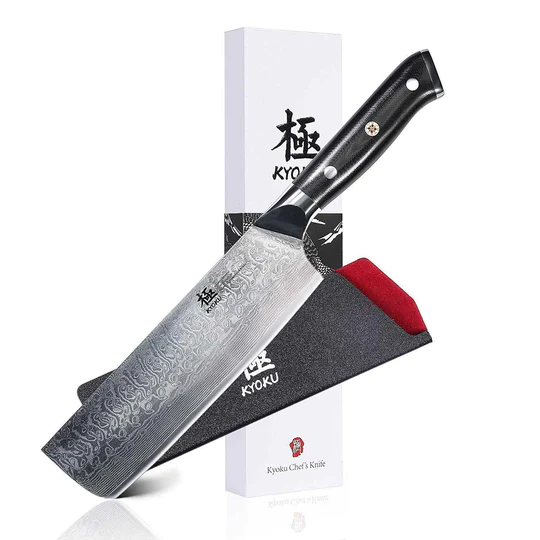


A knife looks simple, but it has many parts that work together. Each part has a job that affects how the knife cuts and feels in your hand. Knowing these parts helps you choose the right knife and use it safely.
The blade has several important parts beyond the sharp edge. The tip, spine, and heel each have different uses when cutting food. These parts affect how the knife handles kitchen tasks.
The handle and connecting parts are just as important as the blade. They keep you safe and make the knife comfortable. Learning about knife anatomy and components helps you cook better and care for your knives.
The blade is the working end of any knife and has four main parts that affect how it cuts. The point gives precision, the edge does the cutting, the spine adds strength, and the heel handles tough tasks.

The point is at the very front where the spine and edge meet. This sharp spot gives you control for detailed work like scoring meat or making small cuts.
The tip runs back from the point along the first few inches of the edge. Use this section for delicate tasks that need finesse.
Paring knives use the point for most tasks. Larger knives use it less, but it remains important for certain techniques. A sharp point makes your knife more versatile. Keeping it sharp lets you do more than just slice and chop.
The cutting edge runs along the bottom of the blade and does the cutting. This sharp part determines how well your knife cuts.
The belly is the curved part of the edge between the tip and heel. This curve helps you rock the knife for chopping.
You need to keep the edge sharp for best results. A dull edge tears food and makes cutting harder. Different blade grinds create different edge shapes for specific tasks.
Kitchen knives like the vegetable cleaver easily chop through harder root veggies, and make short work of dicing, slicing, and mincing for stir-fries and salads.
The spine is the top edge of the blade, opposite the cutting edge. This thick, unsharpened part adds strength and helps balance the blade.
You can use the spine to crush garlic or scrape ingredients from your cutting board. The spine won’t damage the board like the sharp edge would. Without a strong spine a sharp edge won’t work well under pressure.
Chef knives and cleavers have thick spines for powerful chopping. The spine’s thickness affects the knife’s durability and cutting power.
The heel is at the back of the cutting edge, near the handle and bolster. This part handles the toughest cutting jobs that need the most force and control.
The heel gives you the strongest cutting point because it sits closest to your hand. This makes tasks like breaking down large vegetables easier.
Chefs use the heel for high-volume prep work. Its position near the handle gives you more leverage and control. The heel works best with proper hand position and technique.
The knife handle provides grip and control. Supporting parts secure the blade and add balance. These parts work together for a safe and comfortable cutting experience.
The handle shape affects your control. A good handle fits your hand and has enough texture to prevent slipping. Most knife handles have full tang or partial tang construction. Full tang means the blade metal runs through the whole handle.
Handle scales are the two pieces attached to both sides of the tang. They create the main grip and protect the tang underneath.
Scales use the same materials as handles. They attach with rivets, screws, or adhesive, depending on the knife.
Quality scales fit tightly against the tang with no gaps. Poorly fitted scales can collect dirt and cause discomfort. Handle scales on kitchen knives are often smooth for easy cleaning. Outdoor knives may have textured scales for better grip.

Rivets are small metal pins that hold the handle scales to the tang. They pass through holes in the scales and tang. Most knives use 2-4 rivets, depending on handle length. Rivets should sit flush with the handle and not stick out.

Loose rivets make the handle wobble or separate from the blade, creating a safety risk and making the knife harder to control. Check for gaps around rivets or movement in the scales to spot problems.
The pommel is the end of the knife handle, farthest from the blade. Not all knives have a visible pommel, but it serves important functions when present.
The pommel adds weight to the handle, helping to balance the knife. This makes cutting motions feel more natural and reduces hand fatigue.
Some knife pommels are removable and hollow for storage. Others are solid and attached permanently. Pommel shapes vary from round to square to decorative. Kitchen knives often have subtle pommels, while outdoor knives may have larger ones.
Several parts connect the blade and handle and protect your hand. The bolster provides balance and safety. It is a thick band of metal between the blade and handle.
The bolster acts as a barrier between your hand and the sharp edge, preventing your fingers from slipping forward. The bolster also improves balance by adding weight near the blade. This gives you better control when cutting.
Visual appeal is another benefit. The bolster adds refinement to the knife’s look. Not all knives have bolsters. Kitchen knives and some tactical knives usually have them. Folding knives often do not.
The tang is the part of the blade that extends into the handle. This connection affects the knife’s strength and balance. Full tang knives handle tough tasks better. Partial tang knives work for lighter jobs.
Full tang runs the entire length and width of the handle. You can see the metal along the handle sides. This design gives maximum strength and durability.
Partial tang extends only partway into the handle and is narrower than the handle. These knives are lighter but less strong.
Rat tail tang uses a thin metal rod inside the handle. Cheaper knives often use this design. It gives enough strength for light tasks.
The choil is a small notch or indentation where the blade meets the handle. You’ll find this feature on both kitchen knives and tactical blades.
Finger placement is the main function of the choil. It gives your index finger a secure spot when you grip the knife, offering better control during precise cutting tasks.
The choil also serves as a sharpening relief. It keeps the sharpening stone from hitting the handle when you maintain the blade edge. Your finger fits naturally into the choil, which reduces hand fatigue during extended use.
Some knives have rounded choils for comfort, while others feature sharp angles for specific cutting techniques. The size changes based on the knife’s purpose.
The quillon consists of projections that extend from the handle toward the blade. You’ll see these more often on tactical knives and historical blade designs.
Hand protection is the primary purpose of quillons. They keep your hand from sliding forward onto the blade during thrusting motions, which is crucial for combat or utility knives.
The quillon also gives you additional grip. You can brace your fingers against these projections for better control, especially during detailed cutting work.
Quillons add weight to the handle area, which can improve how the knife feels in your hand. Modern kitchen knives rarely include quillons. You’ll find them more often on fixed-blade tactical knives and traditional designs. The size and shape change based on the knife’s function.
Pocket and folding knives have different parts than fixed-blade knives. These knives use special mechanisms to fold and lock safely.
Pocket knives have a pivot pin that lets the blade fold into the handle. This pin acts as a hinge between the blade and handle, letting the blade rotate when you open or close the knife.
The lock mechanism keeps the blade open during use. Common types include:
Many folding knives have a thumb stud or thumb hole to help you open the blade with one hand. Some knives have a flipper tab on the blade’s back edge instead.
The blade tang in folding knives sits inside the handle when closed. The tang connects to the pivot pin and works with the locking system.
Folding knife handles are more complex than fixed-blade handles. They need space for the folded blade and internal mechanisms. The handle has scales or slabs that cover the internal parts.
Liners sit between the scales and internal parts. These thin metal pieces add strength and hold the locking mechanism. Some knives use a frame construction where the handle sides act as the liners.
The backspacer fills the gap between handle scales at the knife’s back. It adds strength and sometimes includes decorative elements or lanyard holes for attaching cords.
Standoffs are small posts that separate the handle scales. They create space for the blade and internal parts and help maintain the knife’s structure when folded.

The knife tip handles precise cutting tasks like detailed work and piercing, while the knife edge does most of the cutting. A sharp edge slices through materials cleanly. The knife spine adds strength to the blade and keeps the knife from bending during use.
The knife heel handles heavy cutting tasks. You use more pressure here for tough jobs. Your knife handle provides grip and control. Different handle designs change how the knife feels in your hand.
The knife bolster also adds balance and weight. It also protects your fingers from sliding onto the blade.
Hunting knives have longer, fixed blades that stay in one position during use. Pocket knives have folding blades that tuck into the handle for safety and portability.
Hunting knives often have fuller grooves in the blade to reduce weight and improve balance. Pocket knives use pivot points and locking mechanisms to keep the blade secure when open. The handles also differ in size and grip texture. Hunting knife handles are usually larger for better control.
Both knife types share basic parts like the edge, spine, and tip. The main differences are in construction and specialized features.
Swords and knives share similar basic parts. Both have blades, handles, and connecting elements. Swords are much longer and heavier, with blades that extend several feet.
Modern knife parts come from sword-making traditions. The names and functions go back to ancient bladesmithing. Swords have extra parts like crossguards and pommels for better balance and hand protection.
The tang construction must support more weight and stress in swords than in knives. The edge geometry follows similar design rules while both use similar steel and sharpening methods.

Knife Buzz offers independent product reviews on a wide range of knives used in the kitchen, home, and outdoors. We make it easy for you to find the right knife at the best price.

Knife Buzz offers independent product reviews on a wide range of knives used in the kitchen, home, outdoors and at work.
The Knife Buzz Team are passionate about reviewing knives and we cater to a targeted audience that needs independent advice before purchasing.
KnifeBuzz.com may earn affiliate commissions on some pages of this website. Knife Buzz is a participant in the Amazon Services LLC Associates Program, an affiliate advertising program designed to provide a means for sites to earn advertising fees by advertising and linking to Amazon.com. Amazon and the Amazon logo are trademarks of Amazon.com, Inc, or its affiliates. When you click links to various merchants on this site and make a purchase, this can result in this site earning a commission. Other affiliate programs and affiliations include, but are not limited to, Google AdSense.